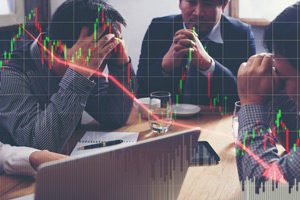We're currently in the longest-running bull market in history. But the longer it goes, the more leery investors seem about a potential stock market crash.
A stock market crash is just one way for a bull market to end. It can also end with a bear market - a drop of 20% or so, but short of the plummet that defines a "crash."

A third option is that markets can trade sideways for extended periods of time, with little gain and little loss, until earnings catch up to and exceed valuations.
That's why it's always important to stay on top of market crash signals. And we've just seen a warning sign that could be one of the biggest yet.
Biggest Sign of Stock Market Crash
It's the direction of the Consumer Confidence Index (CCI). The index is tabulated every month by the Conference Board, a think tank that tracks economic data. The CCI follows consumer business, employment, and income expectations in the economy.
Over the last year, it's been comparatively high. But it dropped in March, from 131.4 to 124.1.
This is still only a short-term development. We need the long-term picture of the CCI if we're going to begin talking about stock market crisis.
Unfortunately, the long run doesn't look good either.
If you chart the consumer confidence index over the last 40 years, recessions follow peaks. The consumer confidence index hits a high and then starts to fall.
That's when a recession happens, and recessions are often catalysts for stock market crashes. The fact that we peaked and then dropped could signal recession down the road.
This isn't a hard and fast rule, but we do intend to watch it over the next several months, because it is a pattern over many decades. If the CCI keeps trending down, a recession could loom and bring about the next stock market crash.
The Consumer Confidence Index: What It's Saying
CCI is derived by asking consumers what they think about business conditions and jobs right now, about their expectations six months out, and whether they are planning to make any major purchases over the next half year.
It provides a snapshot of the economic mood of consumers in the United States, but also of whether their spending will go up, down, or sideways.
ELECTION UPDATE: Michigan just legalized adult-use marijuana. Three stocks to watch now.
Consumer spending constitutes roughly 70% of U.S. gross domestic product (GDP) - when consumers spend less, companies miss their profit forecasts, and a bear market comes ambling ever closer.
Now, it's clear that market direction is never driven just by one indicator, no matter how important it may be. Investors also need to examine other data points to see if they follow a similar trend.
But here's why a stock market crash could arrive sooner than you think - and some signs to watch out for so you can stay protected.
Why a Stock Market Crash Is Now More Likely
[mmpazkzone name="in-story" network="9794" site="307044" id="137008" type="4"]
Last month, the Commerce Department indicated that December consumer spending dropped 0.6% but rose in January by a tiny 0.1%.
The bad news is the January figure was below what economists had forecast. They thought consumer spending would rise by 0.3%, but they missed the mark by 2%.
The U.S. Federal Reserve also lowered its forecast for 2019 GDP growth to 2.1% from its December forecast of 2.3%.
Plus, there is growing evidence that consumer debt is ballooning and consumers are struggling to make their monthly payments.
U.S. consumer debt reached $4 trillion at year-end 2018, a record, as reported by the U.S. Federal Reserve. Student loan debt constitutes $1.5 trillion of the total, and debt on credit cards constitutes another $1 trillion.
And in February, the Fed reported another record: 7 million consumers in the United States were 90 days or more behind on monthly car loan payments in December. That's a red flag, given that unemployment and inflation are both exceptionally low.
Signs of consumers failing to keep current with their loans for long periods of time - long enough to be in danger of having their car repossessed - is a very bad sign about consumer financial health.
The numbers of people failing to pay their credit card every month is also inching upward. At year-end 2016, it was 1.79%. At year-end 2017, it was 1.87%. By 2018, it was 1.94%.
TransUnion, the credit monitoring agency, estimates that credit card delinquencies will climb to 2.04% by year-end 2019.
It's time for investors to pay attention to what the American consumer is telling the markets. Staying abreast all the latest economic metrics, you can make investment decisions that not only protect your portfolio against recession but can actually earn you profits.
These 3 Stocks Are the Key to 2019's Greatest Profits
The 2018 midterm election was a turning point for the cannabis industry.
We expect nothing short of historic profits by the end of the year.
But not all pot stocks will hand you life-changing wins. In fact, often the companies making headlines are least likely to see the biggest gains.
These three stocks, on the other hand, are flying under the radar... for now. Each of them could see exponential stock price acceleration at any moment, and if you get in before that happens, you could turn a token stake into a lifetime of wealth.
I don't know of any other sector providing anywhere near this level of growth now.


